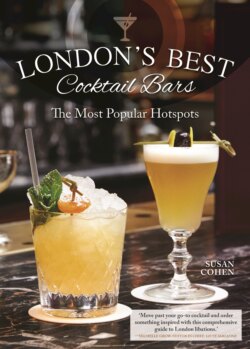Читать книгу London's Best Cocktail Bars - Susan Cohen G. - Страница 6
На сайте Литреса книга снята с продажи.
Introduction
ОглавлениеExactly where and how the cocktail started is somewhat of a mystery; there are plenty of myths and legends around. Some say the name came from the practice of docking a horse’s tail to show it was not a purebred. So, if you drank a cocktail, you were thought to be trying to elevate your social standing. Or maybe it comes from ‘cock tailings’, where the ‘cock’ was the tap of a barrel and the ‘tails’ were the dregs collected inside it. Regardless of whether either of these stories is true, there is a popular belief that the American cocktail is more than 200 years old, and that the martini, which author E. B. White called ‘the elixir of quietude’, has most definitely been around for more than 150 years. In fact, some of the best-known cocktails—the martini, the daiquiri, and the Manhattan—appeared between the 1860s and 1920, the year that Prohibition was introduced in America. For the next thirteen years, bootlegged alcohol and illegal drinking went underground into speakeasies, and as a result, bartenders became more inventive.
‘Shaken, not stirred’. —James Bond
‘Happiness is...finding two olives in your martini when you’re hungry’. —Johnny Carson
Meanwhile, as transatlantic travel became more popular in the late 19th and early 20th centuries, cocktails reached our shores here in the UK. In response, many American bars opened up in London, with inspired bartenders serving these mixed or ‘American’ style drinks. Amongst the great names was The Savoy, who employed the first famous, and first female, bartender in 1903. Ada ‘Coley’ Coleman, whose signature cocktail was the Hanky Panky, took London by storm, and was followed by the inspirational Harry Craddock. He left America during Prohibition and in 1930 compiled The Savoy Cocktail Book, famously proclaiming cocktails to be ‘the finest appetisers known’. His classic creations include the Corpse Reviver No. 2, one of the family of cocktails which are claimed to cure a hangover, and the Sherry Flip, made up simply of an egg yolk and sherry. Yet another classic cocktail bible, The Official Mixer’s Manual, written by Patrick Gavin Duffy in 1934, included recipes for the improbable sounding Monkey Gland and Bosom Caresser.
When it comes to the cocktail party, British author Alec Waugh claimed responsibility for inventing this social gathering in 1925. He explained how he was looking for something to do between 5.30pm and 7.30pm, and so he invited some friends to join him for drinks at his London home. But the English were devoted to tea, and he was disappointed when only one person turned up. Undeterred, he tried again in the autumn of 1925, and this time was economical with the truth, asking thirty people to tea at 5.00pm. They eagerly expected a cup of Earl Grey, but their hopes faded when, much to their amazement, Waugh produced his surprise in the form of ‘a beaker of Daiquiris’. So, it seems, the cocktail party was born, and when Waugh returned from his next book tour, he found a nation where cocktails had replaced tea after 5.00pm.
‘I never go jogging, it makes me spill my martini’. —George Burns
Today, mixologists create exciting cocktails using the finest, and often unusual, natural ingredients sourced from near and far, and produce mixes which make the most of seasonal plants, herbs, and spices. Trends in cocktails are associated with different eras and can transport you to a different decade, from the 19th century through the Prohibition era and the Second World War to the Swinging Sixties. Hollywood films are loaded with cocktails—from the 1930s’ The Thin Man: Murder over Cocktails, through Marilyn Monroe’s Manhattan in Some Like It Hot, to Barbra Streisand’s 1968 green crème de menthe frappe in Funny Girl, to the Dude’s White Russian in the 1998 film The Big Lebowski.
The bars in this guide are a selection of the best that London has to offer, from legendary sophisticated venues, to American bars, to themed spots and tiny speakeasies. There are places for a pre-theatre drink, places to unwind after a hard day at work, and places where you can spend time relaxing in quiet or not-so-quiet surroundings, depending on your mood. Some of the locations offer cocktail masterclasses so you can hone your skills and become a master of mixology. Others specialise in gin, vodka, or whisky-based cocktails, whilst champagne cocktails have many a follower, too. The bartenders in these establishments are devoted to their craft, and though they are always innovative, creating drinks to tickle the fancy, they still mix those eternal classics—for there are some cocktails that cannot and will not ever go out of fashion. The martini is a perfect example: the ingredients are simple, but it is hard to beat. From James Bond’s widely recognized instruction that it be ‘shaken not stirred’, to Ernest Hemingway’s declaration in A Farewell to Arms, ‘I’ve never tasted anything so cool and clean. They made me feel civilized’, this gin-based drink has been, and will continue to be, a star in the cocktail bible.
So, hit the streets of London with this book as your guide, and choose the bar that best suits your mood or takes your fancy; you won’t be disappointed, and you’ll definitely want to try as many of these unique, fun, and trendy places as you can.
